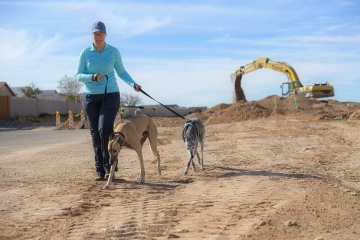Pursuit of a Valley fever vaccine passes significant milestone
A human Valley fever vaccine candidate will proceed toward Phase 1 clinical trials thanks to a major investment from the National Institutes of Health.

Coccidioides fungal spores can become airborne in dust when the soil is disturbed, posing a risk of Valley fever.
Photo by Kris Hanning, U of A Health Sciences Office of Communications
Since settling in Arizona in 1978, John Galgiani, MD, has treated thousands of patients with Valley fever, some of whom left an indelible impression on his heart and soul.

John Galgiani, MD, has dedicated more than four decades to advancing research and clinical care for Valley fever.
Photo by Kris Hanning, U of A Health Sciences Office of Communications
“There was one patient in particular who had a genetic problem that led to a terrible, terrible outcome and the loss of that person to their family. And we couldn’t help her,” Galgiani remembered.
That woman and all of Galgiani’s patients – past, present and future – fuel his passion for fighting Valley fever with awareness, education and, most of all, science.
“Why some people get sick and others don’t is a fascinating question,” said Galgiani, a professor in the Department of Medicine’s Division of Infectious Diseases at the University of Arizona College of Medicine – Tucson and director of the Valley Fever Center for Excellence, which he founded in 1996. “The other really exciting idea is that we might be able to prevent this disease with a vaccine.”
Researchers just took a giant step forward in making that idea a reality, as new National Institutes of Health funding is advancing a human vaccine candidate for Valley fever, formally known as coccidioidomycosis or cocci.
The significant milestone builds on the successful testing of a canine vaccine candidate for Valley fever that is under review by the U.S. Department of Agriculture’s Center for Veterinary Biologics. If approved, it would be the world’s first vaccine against a fungal infection.
Protection at both ends of the leash
In 2021, a U of A College of Medicine – Tucson-led study showed that two doses of a vaccine candidate provided dogs with a high level of protection against Coccidioides posadasii, a fungus that causes Valley fever. The study was a collaboration between the University of Arizona, Colorado State University, and Anivive Life Sciences, a U of A startup that exclusively licensed the technology through Tech Launch Arizona.

The success of the Valley fever vaccine candidate in dogs has researchers optimistic that it could eventually protect humans as well.
Photo by Kris Hanning, U of A Health Sciences Office of Communications
Anivive was recently awarded a contract by the National Institute of Allergy and Infectious Diseases, a division of the NIH, with first-year funding of $4.8 million and additional funding of up to $33 million to adapt the canine vaccine candidate for humans. The funding, some of which will be earmarked for the University of Arizona, will assist with the research, including the manufacturing, formulation, safety testing and support for a Phase 1 human clinical trial.
“There is really no reason, based on the biology, that the canine vaccine candidate couldn’t also be developed to protect humans, and that is a very exciting possibility,” said Galgiani, who is a member of the university’s BIO5 Institute and sees patients through Banner Health’s Valley Fever Center at Banner – University Medical Center in Phoenix and Tucson.
A viable vaccine, canine or human, would fill an immense need in the Southwest. An estimated $60 million per year is spent treating Valley fever in dogs, which are significantly more susceptible to the disease than humans, said Edward Robb, DVM, chief strategy officer for Anivive Lifesciences.
Indeed, it was Arizona dog owners who provided the initial grassroots funding that advanced the research to develop the canine vaccine candidate. Significant philanthropic support from a wide variety of donors has continued to advance the work.
The economic impact of Valley fever in humans far exceeds that of dogs. A 2021 U of A Health Sciences study estimated total lifetime costs at $736 million for the 10,359 Valley fever patients diagnosed in Arizona in 2019. Researchers found that disseminated Valley fever, in which the disease spreads to other parts of the body, resulted in the highest economic burden, at nearly $1.4 million per person.
“Two-thirds of all U.S. infections occur in our state. Surprisingly, many times patients who should be tested for Valley fever are not,” Galgiani said. “There are more than 25 million people at risk of contracting Valley fever, and we do not yet have a vaccine to prevent it. The impact on this population is similar to that of polio before we had a vaccine. It’s just that polio was a worldwide problem, whereas Valley fever risk exists in a relatively small geographic area.”
Demystifying the desert’s disease
Southern Arizona’s low rainfall, high summer temperatures and moderate winter temperatures present the perfect environment for Coccidioides fungal spores to thrive in the soil. When the soil is disrupted by wind, earthquakes or activities such as construction, gardening or bicycling, the spores can become airborne, causing Valley fever when inhaled. Endemic areas include the southwestern U.S. (central California, Southern Arizona, New Mexico and western Texas), northern Mexico, and parts of Central and South America, though that is expanding. Coccidioides recently have been identified in parts of Utah and Washington. Based upon climate change forecasts, the Valley fever fungus may spread as far north as the Canadian border by the end of this century.
“Two-thirds of all U.S. infections occur in our state.”
—John Galgiani, MD
For people who have never had Valley fever, the chance of infection is about 3% per year, and the risk is cumulative. Cases have been seen in states across the U.S., as many visitors from non-endemic areas, where physicians may not be familiar with the disease, develop Valley fever after returning home from the Southwest.
Symptoms of Valley fever include fatigue, cough, chest pain, fever, rash, headache, joint aches and night sweats. About 5% of patients develop residual lung nodules and another 5% develop lung cavities that may rupture, causing chest pain and difficulty breathing. Approximately 1% to 2% of cases become disseminated and spread to the skin, bones or joints. Coccidioidal meningitis is the most severe complication, which, if untreated, is lethal.
Through the years, experts at the Valley Fever Center for Excellence have made significant contributions to the overall knowledge base about Valley fever, including research that led to the anti-fungal drug fluconazole becoming an approved treatment for Valley fever. Because Banner Health is the University of Arizona’s clinical partner, Valley Fever Center physicians affiliated with Banner in Tucson and Phoenix have helped get patients with Valley fever diagnosed sooner.

Soil disturbed by construction can carry Coccidioides fungal spores, which present a risk of Valley fever when inhaled.
Photo by Kris Hanning, U of A Health Sciences Office of Communications
Without the physician-scientists, veterinarians and researchers at the University of Arizona, the current vaccine candidates would not exist.
Marc Orbach, PhD, a plant sciences professor at the College of Agriculture, Environmental and Life Sciences, discovered that Coccidioides and Cochliobolus, a corn fungus, share a common gene, CPS1. Removing CPS1 from the corn fungus made it less harmful. Doing the same to Coccidioides made it completely harmless in rodent models, and when used as a vaccine it proved to be very protective against subsequent otherwise-lethal Valley fever infection. These discoveries were made along with Lisa Shubitz, DVM, a Valley Fever Center researcher and veterinarian.
The intellectual property and innovations from that research found a home with Anivive thanks to Tech Launch Arizona, the university’s commercialization arm that connects faculty, researchers, staff and students with technology and business communities. Tech Launch Arizona creates commercial pathways to the marketplace, where Arizona inventions can create lasting social and economic impact.
As for Galgiani, his contributions cannot be overstated. The discoveries made by the collaboration of Orbach and Shubitz only occurred because there was a Valley Fever Center for Excellence that brought them together.
In addition to research and patient care, Galgiani helps inform national policy by working with state and national legislators and groups such as the Congressional Valley Fever Task Force and the National Academies. For his career’s work, he was presented with the Arizona Bioindustry Association’s Pioneer Lifetime Achievement Award last year and the U of A’s inaugural Distinguished Director’s Award in 2022. The latter award recognizes outstanding performances of department heads or directors whose vision, courage, standards and effectiveness have been transformative.
“There is growing concern about Valley fever, both as a significant public health problem today and the possibility that it might expand considerably in the future due to the effects of climate change. California has added Valley fever as one of the human health metrics that it tracks regarding the impact of climate change,” Galgiani said. “The greater awareness emerging now about this disease is what the Valley Fever Center for Excellence has been advocating for more than a quarter century.
“The support of the NIH to progress the vaccine to humans is the peak of my career of more than 40 years as a researcher, physician and advocate dedicated to Valley fever awareness and solutions.”
Experts
John Galgiani, MD
Director, Valley Fever Center for Excellence
Professor, Department of Medicine, U of A College of Medicine – Tucson
Professor, Department of Immunobiology
Professor, Department of Internal Medicine
Member, BIO5 Institute
Lisa Shubitz, DVM
Associate Research Professor, Animal and Comparative Biomedical Sciences, U of A College of Agriculture, Life and Environmental Sciences
Research Scientist, Valley Fever Center for Excellence
Contact
Stacy Pigott
U of A Health Sciences Office of Communications
520-621-7239, spigott@arizona.edu

